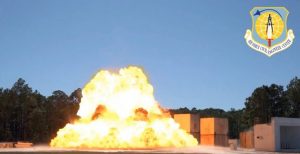Video: WoodWorks blast testing shows mass timber strength

Image © Air Force Civil Engineering Center, Tyndall Air Force Base
Following a promising previous round of testing, WoodWorks–Wood Products Council, in cooperation with the USDA Forest Service Forest Products Lab (FPL) and Softwood Lumber Board (SLB), conducted a second series of blast tests on three existing two-story, single-bay cross-laminated timber (CLT) structures at Tyndall Air Force Base in Florida. The council reported positive observations from the blast site, with all structures remaining intact under significant explosive loading.
“Last year, we tested the structures under their own self-weight,” said Bill Parsons, vice-president of Operations for WoodWorks. “Those tests were successful and, this year, we built on that effort by testing whether the design methods established as a result of those initial tests needed to be adjusted when the buildings carried typical gravity loads and included different connection configurations, increased panel thickness, and alternate mass timber wall systems.”
Researchers performed four tests covering a spectrum of blast loads. For the first two tests, the size of the blast load and configuration of the structures were the same as previous testing, except the structures had axially-loaded front panels, intended to simulate conditions associated with a five-story building. In further testing, different variables were altered on each building; one used five-ply CLT front wall panels, the second used off-the-shelf prefabricated angle brackets, and the third included nail-laminated timber (NLT) front panels.
All three structures remained standing following all four tests; panel rupture was expected and observed on all front and side wall panels, but the buildings maintained enough residual capacity to remain intact and safe to enter.
To view more of WoodWorks blast testing, check out their YouTube channel.



